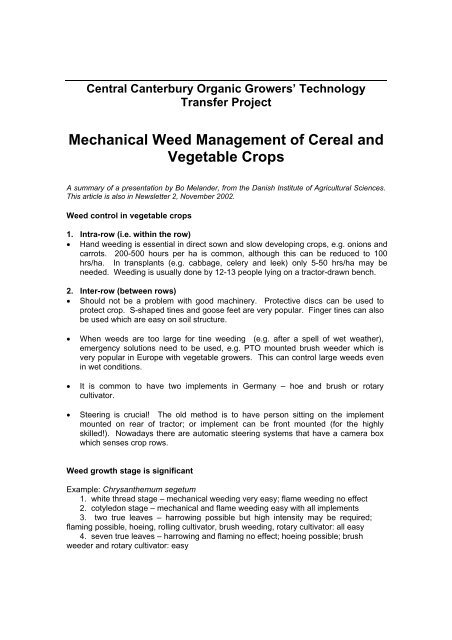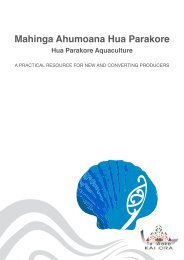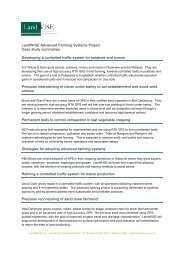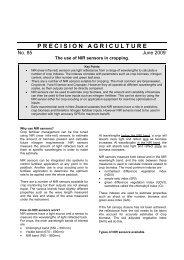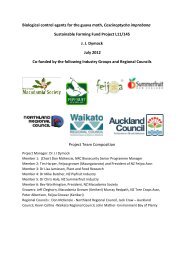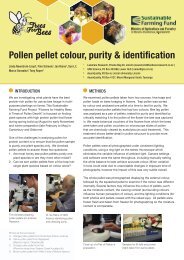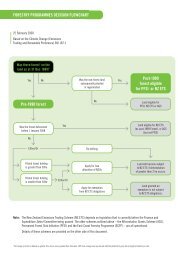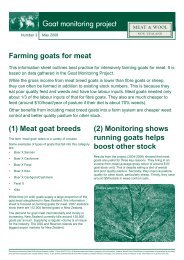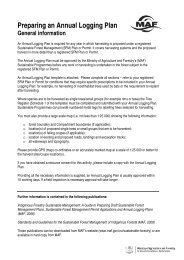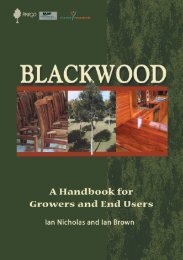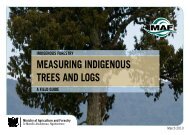Mechanical Weed Management of Cereal and Vegetable Crops
Mechanical Weed Management of Cereal and Vegetable Crops
Mechanical Weed Management of Cereal and Vegetable Crops
You also want an ePaper? Increase the reach of your titles
YUMPU automatically turns print PDFs into web optimized ePapers that Google loves.
• Wheels with rubber fingers – effective on small weeds <strong>and</strong> well established crops.3. Brush weeder• Vertical brushes on either side <strong>of</strong> crop row (e.g. onions).• Can move soil onto row or away from it.4. Torsion• Goose foot <strong>and</strong> fingers with protective shields5. Hoeing close to row• 50 cm row space/ 2.5 cm from crop plants in single rows (steering crucial!!). Soilcan be marked with conical wheel to make steering easier.Strategies for direct sown onions• Start with false seedbed <strong>and</strong> delay sowing• Sow in single rows• Pre-emergent flame weed or harrow• Possibly flame weed at flag leaf stage – risky• Vertical brush weed at 6-8 cm (moving soil away)• Second brush at 8-10 cm (move soil in)• H<strong>and</strong> weed• Brush or weed harrow at 10-12 cm if necessary• Inter-row harrowing if requiredStrategies for direct sown carrots• False seedbed <strong>and</strong> delayed sowing• Preferably sow in single rows• Use a competitive variety with a large canopy to suppress late emergent weeds• Pre-emergent flame weed• H<strong>and</strong> weed twice• Regular inter-row hoeing close to the rows, ridging when possible<strong>Weed</strong> control in cereal crops (Using weed harrowing <strong>and</strong> inter-row hoeing withincreased row spacing)Strategy for weed harrowing in spring cereals• Pre-emergent – 1-2 days before crop emerges <strong>and</strong> before the weeds develop trueleaves• Post emergent – when the crop is at 2-3 leaf stage. Very effective but risk damage.If very competitive weeds are present, the sooner the better.• Selective – when crop starts to elongate. Effective against weed species with aprostrate growth habit <strong>and</strong> no tap root. Controls weakly rooted <strong>and</strong> climbing weedsspecies very effectively; high crop tolerance; can go fast (8-10 km/hr) with littledamage; row space 25 cm (but could use 12 cm).• Some farmers use only one – most use pre <strong>and</strong> post. If doing pre always follow withpost
Factors to consider• Growth stage difference between crop <strong>and</strong> weeds• Pre-emergent harrowing important• <strong>Weed</strong> species composition <strong>and</strong> weed pressure affect timing• Seed bed preparation (level) important• Crop seed vitality <strong>and</strong> variety important <strong>and</strong> sowing rate increase by 10-20%• Nutrient placement (use <strong>of</strong> slurry in Europe)• WeatherInter-row hoeingAdvantages <strong>of</strong> hoeing:• Effective inter-row control <strong>of</strong> troublesome weeds (e.g. taproots)• Some control <strong>of</strong> perennials• Less sensitivity to timing• Breaks soil crustsDisadvantages:• Steering is crucial• Low intra-row weed control• Low working capacity• Yield decline due to wider row spaceKey notes• The above techniques are a “toolbox” <strong>of</strong> possible methods. The appropriate oneswill depend on the crop, the growth stage <strong>of</strong> the weeds, weather, etc.• In Denmark/ northern Europe summer temperatures are lower <strong>and</strong> it is usually lesswindy than in New Zeal<strong>and</strong> so farmers are not as concerned about cultivating <strong>and</strong>losing organic matter.• <strong>Weed</strong> growth stage is significant (see box).• Try to get rid <strong>of</strong> perennial weeds.• Avoid stony soils.• Heavy <strong>and</strong> wet soils are more difficult.• H<strong>and</strong> weeding may still be needed.• Need to have intensive weed control in other crops in the rotation.• Start on a small area.


